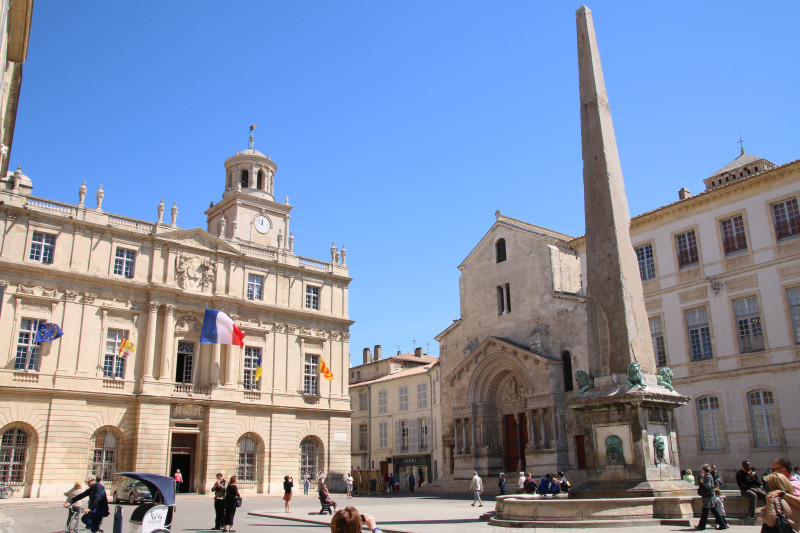The ancient Obelisk
Historic site and monumentPresentation
Date: 4th century
Period: Antiquity
Type : Public votive architecture
Status: Public property Classified as a Historic Monument (1840), UNESCO World Heritage Site (1981)
Period: Antiquity
Type : Public votive architecture
Status: Public property Classified as a Historic Monument (1840), UNESCO World Heritage Site (1981)
The great stone needle, a kind of pivot for the Place de la République, actually originates from the Roman circus and dates back to the end of Antiquity. Discovered in the 14th century, it wasn't until the 17th century that the obelisk resumed its role as a solar symbol. With great difficulty, it was transported and installed in front of the newly-built town hall. Embellished with a fountain and a pool, the obelisk demonstrates the harmony of the many different facades lining the square. It's also the best vantage point from which to take in the vast panorama of the Place de la République. An ancient solar and imperial symbol and decorative element, the obelisk also had a practical function as a landmark in the heart of the Roman circus, for the charioteers.
We now know that the edifice was carved from granite from a Roman quarry in Asia Minor. Monolithic in design (it was broken in two at the end of Antiquity), it measures, with the pedestal designed by Arles architect Jacques Peytret, some twenty meters. Fassin and Lieutaud (1909) give the following details: 15m26 high, 1m70 wide at the base, and 4m55 high for the pedestal. The tip was topped by a bronze globe dotted with fleur-de-lis, surmounted by a golden sun. The obelisk comes from the spina (central wall around which the ring runs) of the Roman circus. It was installed there during major alterations to the building in the 4th century. When the circus was abandoned in the 6th century, the obelisk collapsed and broke in two. Rediscovered in 1389, it was regularly shown to distinguished visitors such as Henri IV, who thought of placing it in the center of the amphitheater. However, it was on Place Royale, in front of the new town hall, that the consuls chose to erect it "for the greater glory of King Louis XIV". Transporting it took forty days, and required colossal resources for a distance of just a few hundred meters. Most of the shaft was located close to the original site, and the four-meter-long tip in Place Antonelle, in the Roquette district... where it served as a bench. But it was even more difficult to erect it on its pedestal (the pedestal's foundations also revealed the existence of Roman baths on the site). Sailors specialized in handling ship masts were called in. On March 26, 1676, the operation was completed with the installation of the point. The royal symbol, a bronze globe surmounted by a sun, was installed. This was later replaced by various other emblems: the Phrygian bonnet, the Napoleonic eagle, the July Monarchy cockerel... before the royal sun was finally removed in 1866. The stone lions, originally placed in the 17th century, were replaced in 1829 by bronze lions sculpted by Dantan. In 1866-1867, Henri Révoil restored the building, adding fountains and a basin decorated with Hercules masks.
We now know that the edifice was carved from granite from a Roman quarry in Asia Minor. Monolithic in design (it was broken in two at the end of Antiquity), it measures, with the pedestal designed by Arles architect Jacques Peytret, some twenty meters. Fassin and Lieutaud (1909) give the following details: 15m26 high, 1m70 wide at the base, and 4m55 high for the pedestal. The tip was topped by a bronze globe dotted with fleur-de-lis, surmounted by a golden sun. The obelisk comes from the spina (central wall around which the ring runs) of the Roman circus. It was installed there during major alterations to the building in the 4th century. When the circus was abandoned in the 6th century, the obelisk collapsed and broke in two. Rediscovered in 1389, it was regularly shown to distinguished visitors such as Henri IV, who thought of placing it in the center of the amphitheater. However, it was on Place Royale, in front of the new town hall, that the consuls chose to erect it "for the greater glory of King Louis XIV". Transporting it took forty days, and required colossal resources for a distance of just a few hundred meters. Most of the shaft was located close to the original site, and the four-meter-long tip in Place Antonelle, in the Roquette district... where it served as a bench. But it was even more difficult to erect it on its pedestal (the pedestal's foundations also revealed the existence of Roman baths on the site). Sailors specialized in handling ship masts were called in. On March 26, 1676, the operation was completed with the installation of the point. The royal symbol, a bronze globe surmounted by a sun, was installed. This was later replaced by various other emblems: the Phrygian bonnet, the Napoleonic eagle, the July Monarchy cockerel... before the royal sun was finally removed in 1866. The stone lions, originally placed in the 17th century, were replaced in 1829 by bronze lions sculpted by Dantan. In 1866-1867, Henri Révoil restored the building, adding fountains and a basin decorated with Hercules masks.
General information
- Environments :
- Town location
- Price :
- Free
- Style :
- Ancient
- Park :
- Camargue Regional Nature Park
Services, Tours, Activities and entertainment
- Historical patrimony :
- Historic patrimony
Contact
The ancient Obelisk
Place De la République
13200
Arles
Phone : +33 4 90 18 41 20
Tarifs
Free of charge.

Destination
L'obélisque romain
Place De la République
13200
Arles
GPS coordinates
Latitude : 43.676346
Longitude : 4.627441



